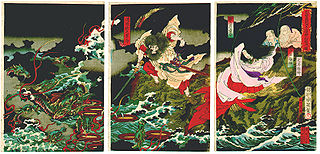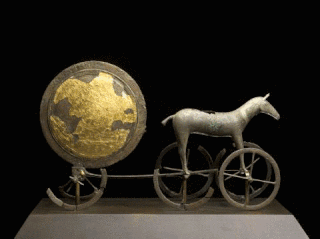Myths
After the dragon Illuyanka wins an encounter with the storm god, the latter asks Inara to give a feast, most probably the Purulli festival. [2] Inara decides to use the feast to lure and defeat Illuyanka, who was her father's archenemy, and enlists the aid of a mortal named Hupasiyas of Zigaratta by becoming his lover. The dragon and his family gorge themselves on the fare at the feast, becoming quite drunk, which allows Hupasiyas to tie a rope around them. Inara's father can then kill Illuyanka, thereby preserving creation. [1] [2]
Inara built a house on a cliff and gave it to Hupasiyas. She left one day with instructions that he was not to look out the window, as he might see his family. But he looked and the sight of his family made him beg to be allowed to return home. It is not known what happened next, but there is speculation [3] that Inara killed Hupasiyas for disobeying her, [1] or for hubris, [4] or that he was allowed to return to his family. [2]
The mother goddess Hannahanna promises Inara land and a man during a consultation by Inara. Inara then disappears. Her father looks for her, joined by Hannahanna with a bee [5] . The story resembles that of Demeter and her daughter Persephone in Greek mythology. [1]

Typhon, also Typhoeus, Typhaon or Typhos, was a monstrous serpentine giant and one of the deadliest creatures in Greek mythology. According to Hesiod, Typhon was the son of Gaia and Tartarus. However, one source has Typhon as the son of Hera alone, while another makes Typhon the offspring of Cronus. Typhon and his mate Echidna were the progenitors of many famous monsters.

In Greek mythology, Python was the serpent, sometimes represented as a medieval-style dragon, living at the center of the Earth, believed by the ancient Greeks to be at Delphi.

In Mesopotamian religion, Tiamat is the primordial sea, mating with Abzû (Apsu), the groundwater, to produce the gods in the Babylonian epic Enûma Elish, which translates as "When on High". She is referred to as a woman, and has, at various points in the epic, both anthropomorphic and theriomorphic features including breasts and a tail.

Yamata no Orochi, or simply Orochi (大蛇), is a legendary eight-headed and eight-tailed Japanese dragon/serpent.

Proto-Indo-European mythology is the body of myths and deities associated with the Proto-Indo-Europeans, speakers of the hypothesized Proto-Indo-European language. Although the mythological motifs are not directly attested – since Proto-Indo-European speakers lived in preliterate societies – scholars of comparative mythology have reconstructed details from inherited similarities found among Indo-European languages, based on the assumption that parts of the Proto-Indo-Europeans' original belief systems survived in the daughter traditions.

In Hittite mythology, Illuyanka was a serpentine dragon slain by Tarḫunz, the Hittite incarnation of the Hurrian god of sky and storm. It is known from Hittite cuneiform tablets found at Çorum-Boğazköy, the former Hittite capital Hattusa. The contest is a ritual of the Hattian spring festival of Puruli.
The religions of the ancient Near East were mostly polytheistic, with some examples of monolatry. Some scholars believe that the similarities between these religions indicate that the religions are related, a belief known as patternism.

Armenian mythology originated in ancient Indo-European traditions, specifically Proto-Armenian, and gradually incorporated Hurro-Urartian, Mesopotamian, Iranian, and Greek beliefs and deities.

Bees have been featured in myth and folklore around the world. Honey and beeswax have been important resources for humans since at least the Mesolithic period, and as a result humans' relationship with bees—particularly honey bees—has ranged from encounters with wild bees to keeping them agriculturally. Bees themselves are often characterized as magically imbued creatures and their honey as a divine gift.
Ḫannaḫanna was a Hittite mother goddess.

Hittite mythology and Hittite religion were the religious beliefs and practices of the Hittites, who created an empire centered in what is now Turkey from c. 1600–1180 BC.
Puruli was a Hattian spring festival, held at Nerik, dedicated to the earth goddess Hannahanna, who is married to a new king.

A weather god or goddess, also frequently known as a storm god or goddess, is a deity in mythology associated with weather phenomena such as thunder, snow, lightning, rain, wind, storms, tornadoes, and hurricanes. Should they only be in charge of one feature of a storm, they will be called after that attribute, such as a rain god or a lightning/thunder god. This singular attribute might then be emphasized more than the generic, all-encompassing term "storm god", though with thunder/lightning gods, the two terms seem interchangeable. They feature commonly in polytheistic religions, especially in Proto-Indo-European ones.
Telipinu was a Hittite god who most likely served as a patron of farming, though he has also been suggested to have been a storm god or an embodiment of crops. He was a son of the weather god Tarḫunna (Taru) and the solar goddess Arinniti in the system of their mythology. His wife was the goddess Ḫatepuna, though he was also paired with Šepuru and Kataḫḫa at various cultic centres.
The Cabiri, a Seattle-based non-profit physical theater troupe, was founded in 1999 by Artistic Director John S. Murphy. In 2001, the troupe became legally incorporated and obtained 501(c)(3) status from the IRS. The mission of The Cabiri and The Anunnaki Project is to preserve the mythologies of cultures that have passed into antiquity, utilizing theatrical, storytelling dance performances, educational presentations, and a free online encyclopedia of terms from folklore and mythology.
Ḫedammu, Hurrian Apše ("Snake"), is a sea-dragon from Hurrian-Hittite mythology, which caused trouble on the Syrian coast. His Hittite counterpart was Illuyanka.

Tarḫunna or Tarḫuna/i was the Hittite weather god. He was also referred to as the "Weather god of Heaven" or the "Lord of the Land of Hatti".
*H₂n̥gʷʰis is a reconstructed Proto-Indo-European term meaning 'serpent', as well as a possible name for a mythological entity, polycephalous sea serpent or dragon which was slain by a hero named Trito with the help of the god Perkʷunos.










